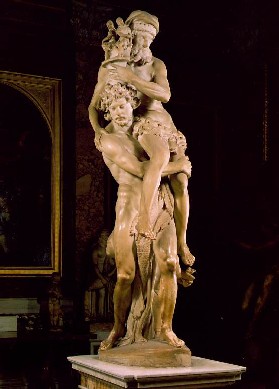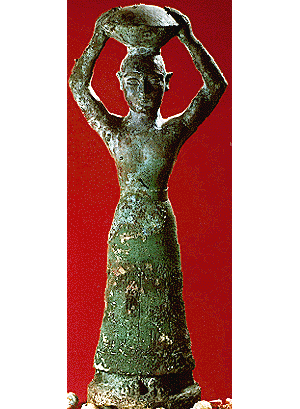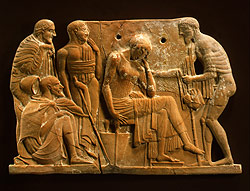
| Prof. Janet Moser |
| English 3181/CompLit 18.1 |
| Fall 2010 |
| Office: 2314B |
| Hours: Tuesday, 10-2 |
| X5195 |
| jmoser@brooklyn.cuny.edu |
| Bernini's Aeneas Carrying Anchises (1618-19) |
THE EPIC GENRE
 |
|
|
Texts: You MUST use the edition and translation indicated: |
| Grades: 2 short papers (3-4 pages, worth 10% and 15%), and one longer final research paper (5-7 pages, worth 20%) 5one-page response papers (15%). midterm exam (15%) and final exam (15%). Quizzes count towards the participation portion of the final grade (10%participation, including quizzes): 10% |
| Course Assignments |
| Gilgamesh |
| Iliad |
| Odyssey |
| Aeneid |
|
Ramayana |
|
Son Jara
|
| Gilgamesh | |
 |

 Humbaba
mask. U. of Penn. Museum
Humbaba
mask. U. of Penn. Museum
Sumerian statuette
Oriental Institute, U. of Chicago
 Cuneiform Tablet. British Museum
Cuneiform Tablet. British Museum
Due Wednesday, Sept 1: Look at this ancient harp player from the Met website:
http://www.metmuseum.org/explore/Greek/Bel1.htm
Look at this website on Mesopotamia from the Met: http://www.metmuseum.org/toah/ht/?period=02®ion=wam
Read p. 61-84 in Gilgamesh. Be sure you have the Penguin/Viking
edition with the Sanders translation (availabe at Shakespeare, and a few copies
available in the Bookstore). Be prepared to discuss Study Guide questions 6-13.
Due Wednesday, Sept. 8:
Finish Gilgamesh. Be prepared to discuss all questions on the Study Guide
One-page RESPONSE paper on Gilgamesh. Due Monday, Sept. 13. You may focus on any of the 4 themes below, meant only as suggestions, or write on any aspect of the text that interests, troubles, surprises you.
| 1. The role of women in Gilgamesh. |
| 2. The role of dreams in the narrative structure of the epic. |
| 3. Gilgamesh as a reflection of the values of his society. |
| 4. Journey as revelation |
| Iliad: Read Books 1, VI for Monday, Sept 13 (p. 4-17 in Packet) If you're not using the Packet, you must use the Fagles translation. | |
Ancient Greece, 1000 BC - 1 AD.: http://www.metmuseum.org/toah/ht/04/eusb/ht04eusb.htm
Greek Gods and Religious Practices.
http://www.metmuseum.org/toah/hd/grlg/hd_grlg.htm
Warfare in Ancient Greece. http://www.metmuseum.org/toah/hd/gwar/hd_gwar.htm
Art of Classical Greece: http://www.metmuseum.org/toah/hd/tacg/hd_tacg.htm
Museum Assignment: OPTIONAL: DUE BY OCTOBER 15:.
This is meant to give you a general idea of the shape of this assignment. It
will be refined:
Turn left after you enter the Great Hall from 5th Ave. and enter the Greek and
Roman galleries. The works you want to see will be in the first room you enter
and in the room immediately to your right.
You want to look at and compare Greek Geometric period (c. 8th-century BCE)
with earlier bronze age Mycenaean (c. 1200 BCE) objects. You want to especially
look at the 3 large Geometric kraters (large vases) --- two are in the center
room and one is in the room to your right. The most important one is the one
on the right in the center room. These kraters were grave markers for aristocratic
families. What were these families trying to convey about their heritage?
In the room to your right, on the left side of the room, are cases labeled Geometric
and Mycenaean. There are both geometric and Mycenaean terracotta works portraying
a goddess sitting in a chair. See especially how alike these two pieces are.
Why is this similarity significant? What does it tell you about these civilizations?
Further along in the galleries on your right are Greek vases portraying stories
about the characters in the Iliad. (These stories don't appear in the Iliad
but come from other sources, now lost). There are several versions of a very
popular theme---Achilles and Ajax playing a board game; there are also portrayals
of the combat between Achilles and an Amazon; the judgment of Paris; Helen returning
to Menelaus. Choose one portrait of a character from the Iliad and discuss what
this depiction brings to, or how it differs from, your concept of that character
from the written text.
See Cranach's Judgment of Paris
from the Met: http://www.metmuseum.org/toah/ho/08/euwc/ho_28.221.htm
See the Met's vase, Judgment of Paris: http://www.flickr.com/photos/ggnyc/3163704431/
 |
|
Ransom of Hector
See Thetis and Achilles sculpture: http://www.metmuseum.org/Works_of_Art/collection_database/Thetis_and_achilles_Pierce_Francis_Connelly/objectview.aspx?OID=20010858&collID=2&dd1=2
Due: Monday, Sept 20:
1. Read Books XVI, XVIII
Due: Wednesday, Sept.22:
XXII, XXIV (through p.56 in Packet)
Response paper 2: Any topic that interests you in your reading.
Or, suggested topics:
1. fire imagery and Achilles
2. The relationship between gods and mortals
3. The portrait of women
4. Achilles as hero
The Odyssey
Amphora with Athena: http://www.metmuseum.org/toah/hd/athl/ho_16.71.htm#
Monday, Sept 27: Read Books 1, 5, 8 of the Odyssey (in the packet)

 Return
of Odysseus (Metropolitan Museum of Art)
Return
of Odysseus (Metropolitan Museum of Art)
papyrus
fragment from the Odyssey
Due: Wed., Sept 29:
Read Books 9, 11, 21, 22 of the Odyssey
http://classics.mit.edu/Homer/odyssey.html
Due Wednesday, Oct. 6 (NOTE CHANGE OF DATE): 3-4 page paper:
Choose one of the following topics. Be sure to support your arguments with
specific references to and quotes from the text.
1. Compare the role of the gods in the Iliad and in the Odyssey.
2. What attributes make Odysseus an epic hero?
3. Describe and analyze the role of women in the Odyssey.
4. One critic has said that the Iliad is the story of death and the Odyssey
is the story of life. Explain.
5. Hospitality as a criterion of civilization in the Odyssey.
6. Parallels between Books 1 and 24 of the Iliad.
7. Aristotle said that the man who is incapable of working in common, or who
in his self-sufficiency has no need of others, is no part of the community,
like a beast or a god. Discuss the figure of Achilles in the light of this statement.
8. Homer’s preferred medium of poetic comparison is the simile rather
than the metaphor, and his similes are extended”: the simile does
more than establish a likeness between A and B; it goes on to describe B in
great detail, some of the details not like A at all. Yet these details, the
apparent development of B for its own sake, often do suggest points of comparison
that lie below the surface, and often, too, they make significant comments on
broader aspects of the situation in which they appear. Discuss the function
of the extended simile in the following passages:
. XXII. lines 194-251
or
. XXIV. lines 563-67
|
|
|
Due: Monday, Oct. 4: Read Books 1 and 2 of the Aeneid Due: Wed., Oct. 6: Read Books 4, 6
of the Aeneid |
|
MIDTERM: Monday, Oct 18: (Gilgamesh, Iliad, Odyssey, Aeneid). Wed., Oct. 20: Read the first half of the Ramayana (up to Book 4 in Packet) Be prepared to discuss the role of dreams, omens, hospitality, the concept of dharma, and the fantastic elements in the Ramayana. Check this site for pictures http://ramayana.berkeley.edu/images/kandas3-7gallery/index.html http://www.columbia.edu/itc/mealac/pritchett/00routesdata/bce_299_200/ramayana/ramayana.html animated video: Sitayana: Prince of Light, YouTube video: http://www.youtube.com/watch?v=DwVZeCLEWrE Monday, Oct. 25- Wed., Oct 27: Read second half of Ramayana
For Monday, Nov. 1: Read Son-Jara (through Episode 4, p. 199-213
in Packet) Be prepared to discuss the following themes in Son-Jara: 1. Epic vs. folkore elements 2. biblical themes 3. Parallels to Mohammed 4. role of the griot 5. role of Fa-Koli 6. female roles 7. Son Jara's ancestry as a metaphor for the Mali empire Monday, Nov. 8: finish Son-Jara. Wednesday, Nov. 10: Beowulf, pp. 3-33. Check this site for maps and images: http://www.heorot.dk/beowulf-on-steorarume_front-page.html Monday, Nov. 15: Wed., Nov. 17: Monday, Nov. 22: Read Omeros, Book 1 (p.3-76) Wed, Nov. 24: Omeros, 79-132 Monday, Nov. 29 Wed., Dec. 1: In-class presentations: Monday., Dec. 6, Wed., Dec 8, Mon., Dec. 13. The last 3 class sessions will be devoted to presentations on your final research paper. These presentations will be brief (5 minutes), and will, I hope, be organized loosely by topic. Ideally, the class will be divided into groups by epics or themes, and the presentations will be grouped accordingly. You must e-mail me your annotated bibliography the day before your presentation. If you are absent on the day you are supposed to present, you will be able to present ONLY if there is sufficient time on the last day class meets (Dec. 13). If you do not present, your final paper grade will be reduced by one letter grade. Final Paper Topics: 1. Images of lamentation. Choose three heroic characters who weep (for example, Achilles, Odysseus, Achille), or for whom others weep (Hector, Enkidu, Beowulf). What does the grief of these heroes, or of those that mourn them, reveal about their roles in society? How is grief, pathos, related to heroism? 2. Choose one pre-Christian and one post-Christian epic. How does the introduction of Christian ideals change the values that shape society’s image of the epic hero? 3. Discuss the role of women in the heroic culture of any three epics we have read this semester. 4. What does the hero’s choice of weapons tell us about him as a fighter and as a person. Compare the weapons and the means of dealing with their enemies chosen by Achilles, Odysseus and Beowulf. 5. Discuss the concept of justice in the Odyssey, the Aeneid, and Beowulf. 6. Discuss the role of dreams in three of the epics read this semester. 7. Compare one character from Omeros with his Greek Homeric counterpart. 8. Discuss the role of the fantastic in Omeros, Son Jara and an older epic of your choice. 9. Mothers, fathers and sons in Omeros and one other epic. 10. Cities have important functions in the heroic works of the ancient
and premodern world. 11. Close reading of any passage from any of the works we've read this semester. Extra credit: Watch the film The Searchers (John Ford, director). Write a 2-page paper analyzing the ways in the which this film can be described as an Amercian epic. Due Monday, Dec. 13 (last day of classes). FINAL EXAM: December 20, 1-3PM, room 3153B Be sure to review the names and roles of the main characters; the background information (in the introductory pages before the texts in the class packet, in the introduction to Beowulf, and in the class notes to Omeros, Son Jara, Ramayana, Beowulf); important dates (of the recording of the texts and of the historical events mentioned in class); stylistic techniques that characterize each epic. There's nothing tricky on this exam. If you've done the reading and
been in class for discussions, you will be prepared.
***************************************************************************************************
3-4 page paper on one of the following comparative topics:
|
|
| Song of Roland
What do these 14th century images tell you about contemporary French impressions of the French people? of the Muslims? |
|
 |
|
| Charlemagne and the Saracens |
Charlemagne receiving the holy nail
|
 |
|
| Death of Roland |
Flight of the Saracens
|
|
Due Tuesday May 7 |
|
Fall 2005 Prof. Moser
2314B; W, 1:45-2:45; Th, 1:45-2:45
e-mail: jmoser@brooklyn.cuny.edu
English 2 Syllabus
Theme: Visions of Hell
Course objectives:
1. Students will read a variety of texts, from different eras and different
cultures.
2. Students will analyze common themes and allusions in these works, and relate
them to historical, cultural and social currents of the time.
3. Students will do close analyses of texts, discussing theme, imagery, poetic
technique.
4. Students will write 2 short, 2-3 page papers, incorporating quotations from
the primary texts to support their points.
5. Students will become familiar with research techniques, library and on-line
resources, proper research format and documentation.
6. Students will write a 7-10 page research paper, using at least seven sources
from both print materials and on-line sources.
Required texts: (Books available at Shakespeare & Co.)
Packet from Far Better Copy (Odyssey, Books 11,12,24; Aeneid, Book 6)
Bible. On line: http://etext.virginia.edu/rsv.browse.html
Dante. Inferno (trans. Mandelbaum). Bantam
Twain. The Mysterious Stranger and Other Stories. Dover
Bulgakov. Master and Margarita. Grove.
C.S. Lewis. The Screwtape Letters. Harper.
Hacker. Pocket Style Manual. Bedford/St.Martins.
Course requirements:
1. Students are expected to have read all the material due at each class meeting.
2. There will be frequent quizzes and reader response papers. Quizzes are graded
P/F. There are no make-ups for missed quizzes.
3. There will be two 2-3 page papers, and a 7-10 page research paper.
4. Students are permitted 3 absences. Two latenesses = one absence.
5. Failure to complete all assignments on time and/or excessive absence will
result in a lowered grade for the course.
6. All work is due when assigned. One of the short papers may be handed in late
(your choice), but no more than one week late. No other late work will be accepted.
7. Students who are absent from class are responsible for getting the assignment
from a classmate before the next class. Homework assignments will also be listed
on the web site. Do not e-mail me for the homework.
8. Plagiarism will result in an automatic F for the course.
9. Possible grades range from A+ to F. The lowest passing grade is C-.
Grades:
15% Participation, quizzes
30% short papers
15% preparatory research (annotated bibliography, outline, notes)
40% research paper
Monday, Sept 12 and Thursday, Sept 15: Odyssey (from Packet)
Monday, Sept 19: Aeneid, Book VI.(from Packet)
Due Monday, Sept 26: 2-page paper comaring and contrasting the Greek and Roman views of the afterlife. Use only primary sources. Be sure to support your assertions with specific quotes and references to the texts.
Due Thursday, September 22:
Bring Style Manual
Aeneid:
What are the values most prized by the Romans (see Anchises' speech in Book 6).
Monday, Oct. 2
Read Matthew 24; Isaiah 14, 26; Revelation 20
Thursday, Oct. 6
Matthew 25; in-class writing
Tuesday, Oct. 11:
Read Cantos 1-5 of the Inferno
Monday, Oct. 17:
Read Cantos 6-15. Be prepared to discuss the study guide questions for Cantos 6-15.
Thursday, Oct. 20:
Read Cantos 16-22. Be prepared to discuss the study guide questions.
Monday, Oct. 24:
Finish the Inferno.
Think about topics for short research paper, due Monday, Oct. 31
3-4 pages. Choose one character (historical or mythological) from the Inferno and find some background information. Write a paper describing the character, with documentation from at least three sources, and discussing Dante's placement of the character in the Inferno. Only one source can be an internet source. The Inferno is your THIRD source.
Monday, Oct. 31:
Read the first half of Twains "Mysterious Stranger."
Thursday, Nov. 3:
Finish the Mysterious Stranger
Summarize Chap 10, p. 111-116 (...at that time)
Thrusday, Nov. 10
To hand in: Satan, Devil or Angel?
Read p. 1-97 in The Screwtape Letters
Monday, Nov. 14
Finish Screwtape Letters
Revise short research paper
Thursday, Nov. 17
Meet in Library, room 120.
Monday, Nov. 21
Read Chapters 1-4 in Master and Margarita
Have a lovely Thanksgiving.
Monday, Nov. 28
Read Chapters 5-12 in Master and Margarita
Thursday, Dec. 1
Read Master and Margarita, Chapters 13-20
Thursday, Dec. 8
Finish Master and Margarita
Monday, Dec. 12
Bibliography for research paper.
Thursday, Dec. 15
Annotated bibliography and outline for research paper.
Wednesday, Dec. 21
Research paper due (in my mailbox by 3PM, or e-mailed to me by 11:59PM). No late papers accepted.